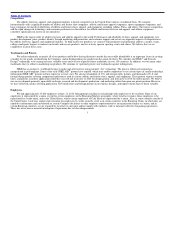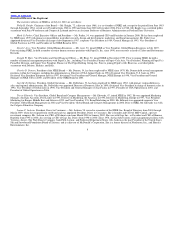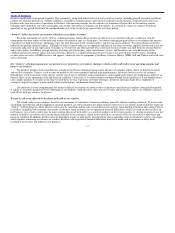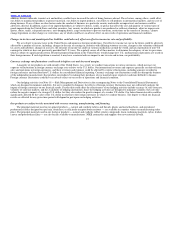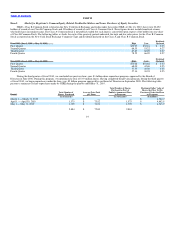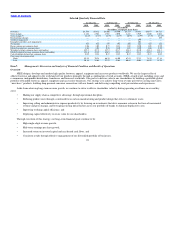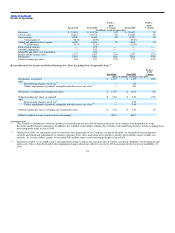Nike 2010 Annual Report Download - page 20
Download and view the complete annual report
Please find page 20 of the 2010 Nike annual report below. You can navigate through the pages in the report by either clicking on the pages listed below, or by using the keyword search tool below to find specific information within the annual report.
Table of Contents
related processes in our global operations. The failure of these systems to operate effectively, problems with transitioning to upgraded or replacement
systems, or a breach in security of these systems could cause delays in product fulfillment and reduced efficiency of our operations, could require significant
capital investments to remediate the problem, and may have an adverse effect on our results of operations and financial condition.
Our financial results may be adversely affected if substantial investments in businesses and operations fail to produce expected returns.
From time to time, we may invest in business infrastructure, acquisitions of new businesses, and expansion of existing businesses, such as our retail
operations, which require substantial cash investments and management attention. We believe cost effective investments are essential to business growth
and profitability. However, significant investments are subject to typical risks and uncertainties inherent in acquiring or expanding a business. The failure of
any significant investment to provide the returns or profitability we expect could have a material adverse effect on our financial results and divert
management attention from more profitable business operations.
We depend on key personnel, the loss of whom would harm our business.
Our future success will depend in part on the continued service of key executive officers and personnel. The loss of the services of any key individual
could harm us. Our future success also depends on our ability to identify, attract and retain additional qualified personnel. Competition for employees in our
industry is intense and we may not be successful in attracting and retaining such personnel.
The sale of a large number of shares held by our Chairman could depress the market price of our common stock.
Philip H. Knight, Co−founder and Chairman of our Board of Directors, beneficially owns over 74% of our Class A Common Stock. If all of his
Class A Common Stock were converted into Class B Common Stock, Mr. Knight would own over 14% of our Class B Common Stock. These shares are
available for resale, subject to the requirements of the U.S. securities laws. The sale or prospect of the sale of a substantial number of these shares could
have an adverse effect on the market price of our common stock.
Anti−takeover provisions may impair an acquisition of the Company or reduce the price of our common stock.
There are provisions of our articles of incorporation and Oregon law that are intended to protect shareholder interests by providing the Board of
Directors a means to attempt to deny coercive takeover attempts or to negotiate with a potential acquirer in order to obtain more favorable terms. Such
provisions include a control share acquisition statute, a freezeout statute, two classes of stock that vote separately on certain issues, and the fact that holders
of Class A Common Stock elect three−fourths of the Board of Directors rounded down to the next whole number. However, such provisions could
discourage, delay or prevent an unsolicited merger, acquisition or other change in control of our company that some shareholders might believe to be in
their best interests or in which shareholders might receive a premium for their common stock over the prevailing market price. These provisions could also
discourage proxy contests for control of the Company.
We may fail to meet analyst expectations, which could cause the price of our stock to decline.
Our Class B Common Stock is traded publicly, and at any given time various securities analysts follow our financial results and issue reports on us.
These reports include information about our historical financial results as well as the analysts’ estimates of our future performance. The analysts’ estimates
are based upon their own opinions and are often different from our estimates or expectations. If our operating results are below the estimates or expectations
of public market analysts and investors, our stock price could decline. In the past, securities class action litigation has been brought against NIKE and other
companies following a decline in the market price of their securities. If our stock price is volatile, we may become involved in this type of litigation in the
future. Any litigation could result in substantial costs and a diversion of management’s attention and resources that are needed to successfully run our
business.
17


